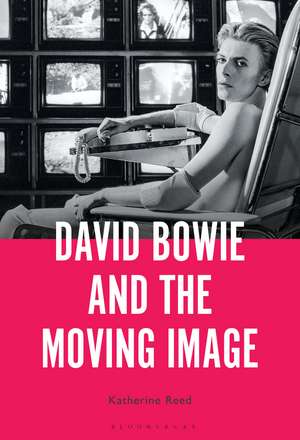David Bowie and the Moving Image: A Standing Cinema
Autor Professor Katherine Reeden Limba Engleză Hardback – 11 ian 2023
Preț: 539.57 lei
Preț vechi: 773.54 lei
-30% Nou
Puncte Express: 809
Preț estimativ în valută:
103.24€ • 107.80$ • 85.45£
103.24€ • 107.80$ • 85.45£
Carte tipărită la comandă
Livrare economică 05-19 aprilie
Preluare comenzi: 021 569.72.76
Specificații
ISBN-13: 9781501371257
ISBN-10: 1501371258
Pagini: 248
Ilustrații: 17 bw illus
Dimensiuni: 152 x 229 x 17 mm
Greutate: 0.5 kg
Editura: Bloomsbury Publishing
Colecția Bloomsbury Academic
Locul publicării:New York, United States
ISBN-10: 1501371258
Pagini: 248
Ilustrații: 17 bw illus
Dimensiuni: 152 x 229 x 17 mm
Greutate: 0.5 kg
Editura: Bloomsbury Publishing
Colecția Bloomsbury Academic
Locul publicării:New York, United States
Caracteristici
Capitalizes on Bowie's current popular culture resurgence to show new ways of thinking about contemporary multimedia pop artists
Notă biografică
Katherine Reed is Assistant Professor of Musicology at California State University, Fullerton, USA. Her research interests include musical semiotics and the use of pre-existing music in film. Reed's work has appeared in Popular Music & Society, Music and the Moving Image, and the Society for American Music's Digital Lecture Series.
Cuprins
List of Figures1. Introduction: Sons of the Silent AgePart I: Bowie as Auteur2. Semiotics and the Creation of "David Bowie"3. Cracked Actor: The Music Video and Bowie as Moving Image4. Screen Dreams: Theatrical Staging, Film, and Diamond DogsPart II: Bowie as Sign5. Hollywood Highs: Acting Roles and Bowie's Star Image6. "Mass Motivation": Advertising, Audience, and the Bowie Star Image7. Who Can I Be Now?: Fannish Creation and Depictions of Bowie on Film8. Conclusion: Living OnBibliographyMedia BibliographyAcknowledgmentsIndex
Recenzii
To focus on the music of David Bowie is understandable. But you're only getting half of the story. Bowie the visual artist-actor, director, scenarist, storyboard artist, painter, 'icon'-is just as essential to his work. Katherine Reed's insightful study goes from the Diamond Dogs tour to Bowie's Vittel and Vuitton TV ads to his afterlife in films and shows how intertwined Bowie the rock musician and Bowie the image (and image-maker) always were.
David Bowie's chameleonic nature was evidence of a keen sense of not just style but how an image could tell a story - and sometimes the more ambiguous the story, the more compelling the image. This wide-ranging study literally looks at David Bowie across media from stage to screen, a musical performer, an actor, a conceptualist, a figure both avant-garde and commercial, an 'alien' who reflected his audience back to themselves.
David Bowie and the Moving Image is an essential starting point for anyone looking to deepen their understanding of this iconic artist. Reed makes a compelling case that Bowie's entire oeuvre is permeated by an audiovisual and theatrical sensibility, always extending beyond the music through the power of the accompanying images, whether it is the charismatic chameleon that is Bowie himself, music videos that channel his performance personae, films in which brand Bowie is a defining feature, commercial spinoffs in advertising, or elaborate film and stage narratives, some of which disintegrated before they could be realised. Reed's writing is erudite and panoramic in its scope, drawing eclectically from musicology, studies of performance and audiovisuality, cultural theory and semiotics. The value of this book is in how it draws all of this together, offering the reader an approachable overview of Bowie's unrivalled and enigmatic explorations in sound and vision.
David Bowie's chameleonic nature was evidence of a keen sense of not just style but how an image could tell a story - and sometimes the more ambiguous the story, the more compelling the image. This wide-ranging study literally looks at David Bowie across media from stage to screen, a musical performer, an actor, a conceptualist, a figure both avant-garde and commercial, an 'alien' who reflected his audience back to themselves.
David Bowie and the Moving Image is an essential starting point for anyone looking to deepen their understanding of this iconic artist. Reed makes a compelling case that Bowie's entire oeuvre is permeated by an audiovisual and theatrical sensibility, always extending beyond the music through the power of the accompanying images, whether it is the charismatic chameleon that is Bowie himself, music videos that channel his performance personae, films in which brand Bowie is a defining feature, commercial spinoffs in advertising, or elaborate film and stage narratives, some of which disintegrated before they could be realised. Reed's writing is erudite and panoramic in its scope, drawing eclectically from musicology, studies of performance and audiovisuality, cultural theory and semiotics. The value of this book is in how it draws all of this together, offering the reader an approachable overview of Bowie's unrivalled and enigmatic explorations in sound and vision.
